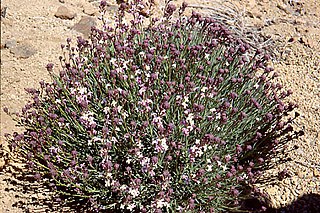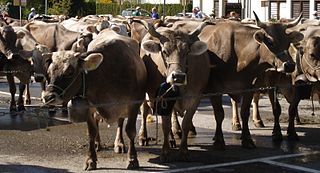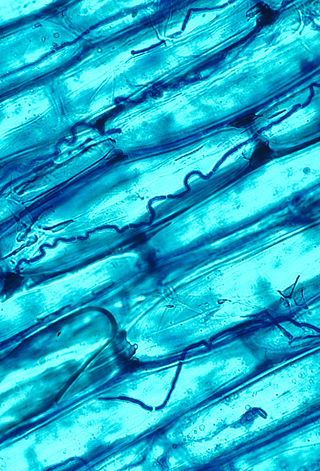Related Research Articles

A herbivore is an animal anatomically and physiologically adapted to eating plant material, for example foliage or marine algae, for the main component of its diet. As a result of their plant diet, herbivorous animals typically have mouthparts adapted to rasping or grinding. Horses and other herbivores have wide flat teeth that are adapted to grinding grass, tree bark, and other tough plant material.

Erysimum, or wallflower, is a genus of flowering plants in the cabbage family, Brassicaceae. It includes more than 150 species, both popular garden plants and many wild forms. The genus Cheiranthus is sometimes included here in whole or in part. Erysimum has since the early 21st century been ascribed to a monogeneric cruciferous tribe, Erysimeae, characterised by sessile, stellate (star-shaped) and/or malpighiaceous (two-sided) trichomes, yellow to orange flowers and multiseeded siliques.

An invasive or alien species is an introduced species to an environment that becomes overpopulated and harms its new environment. Invasive species adversely affect habitats and bioregions, causing ecological, environmental, and/or economic damage. The term can also be used for native species that become harmful to their native environment after human alterations to its food web – for example, the purple sea urchin which has decimated kelp forests along the northern California coast due to overharvesting of its natural predator, the California sea otter. Since the 20th century, invasive species have become a serious economic, social, and environmental threat worldwide.

An introduced species, alien species, exotic species, adventive species, immigrant species, foreign species, non-indigenous species, or non-native species is a species living outside its native distributional range, but which has arrived there by human activity, directly or indirectly, and either deliberately or accidentally. Non-native species can have various effects on the local ecosystem. Introduced species that become established and spread beyond the place of introduction are considered naturalized. The process of human-caused introduction is distinguished from biological colonization, in which species spread to new areas through "natural" (non-human) means such as storms and rafting. The Latin expression neobiota captures the characteristic that these species are new biota to their environment in terms of established biological network relationships. Neobiota can further be divided into neozoa and neophyta (plants).

Centaurea diffusa, also known as diffuse knapweed, white knapweed or tumble knapweed, is a member of the genus Centaurea in the family Asteraceae. This species is common throughout western North America but is not actually native to the North American continent, but to the eastern Mediterranean.

Plant defense against herbivory or host-plant resistance (HPR) is a range of adaptations evolved by plants which improve their survival and reproduction by reducing the impact of herbivores. Plants can sense being touched, and they can use several strategies to defend against damage caused by herbivores. Many plants produce secondary metabolites, known as allelochemicals, that influence the behavior, growth, or survival of herbivores. These chemical defenses can act as repellents or toxins to herbivores or reduce plant digestibility. Another defensive strategy of plants is changing their attractiveness. To prevent overconsumption by large herbivores, plants alter their appearance by changing their size or quality, reducing the rate at which they are consumed.
Trophic cascades are powerful indirect interactions that can control entire ecosystems, occurring when a trophic level in a food web is suppressed. For example, a top-down cascade will occur if predators are effective enough in predation to reduce the abundance, or alter the behavior of their prey, thereby releasing the next lower trophic level from predation.

In ecology, a community is a group or association of populations of two or more different species occupying the same geographical area at the same time, also known as a biocoenosis, biotic community, biological community, ecological community, or life assemblage. The term community has a variety of uses. In its simplest form it refers to groups of organisms in a specific place or time, for example, "the fish community of Lake Ontario before industrialization".
The evolution of increased competitive ability (EICA) hypothesis was first proposed by Bernd Blossey and Rolf Nötzold in 1995 as a way to explain the success of invasive, non-indigenous species. Observing that:
- there is usually a lag period between the time of introduction of an invasive species and the point at which it is considered invasive, and
- invasive plants seem to be more virulent in habitats into which they have been introduced, the scientists presumed a sort of naturalization through modification for non-indigenous plants.
In ecology, a priority effect refers to the impact that a particular species can have on community development as a result of its prior arrival at a site. There are two basic types of priority effects: inhibitory and facilitative. An inhibitory priority effect occurs when a species that arrives first at a site negatively affects a species that arrives later by reducing the availability of space or resources. In contrast, a facilitative priority effect occurs when a species that arrives first at a site alters abiotic or biotic conditions in ways that positively affect a species that arrives later. Inhibitory priority effects have been documented more frequently than facilitative priority effects. Studies indicate that both abiotic and biotic factors can affect the strength of priority effects. Priority effects are a central and pervasive element of ecological community development that have significant implications for natural systems and ecological restoration efforts.
The Janzen–Connell hypothesis is a well-known hypothesis for the maintenance of high species biodiversity in the tropics. It was published independently in the early 1970s by Daniel Janzen, who focused on tropical trees, and Joseph Connell who discussed trees and marine invertebrates. According to their hypothesis, host-specific herbivores, pathogens, or other natural enemies make the areas near a parent tree inhospitable for the survival of seeds or seedlings. These natural enemies are referred to as 'distance-responsive predators' if they kill seeds or seedlings near the parent tree, or 'density-dependent predators' if they kill seeds or seedlings where they are most abundant. Such predators can prevent any one species from dominating the landscape, because if that species is too common, there will be few safe places for its seedlings to survive. Both Janzen and Connell originally proposed that for natural enemies to increase local diversity, they must be host-specific and relatively immobile, such that they disproportionately reduce the density of the more locally common tree species. This prevents any one species from becoming dominant and excluding other species through competition, allowing more species to coexist in small areas. This can be classified as a stabilizing mechanism.

Ecological fitting is "the process whereby organisms colonize and persist in novel environments, use novel resources or form novel associations with other species as a result of the suites of traits that they carry at the time they encounter the novel condition". It can be understood as a situation in which a species' interactions with its biotic and abiotic environment seem to indicate a history of coevolution, when in actuality the relevant traits evolved in response to a different set of biotic and abiotic conditions.

Plant use of endophytic fungi in defense occurs when endophytic fungi, which live symbiotically with the majority of plants by entering their cells, are utilized as an indirect defense against herbivores. In exchange for carbohydrate energy resources, the fungus provides benefits to the plant which can include increased water or nutrient uptake and protection from phytophagous insects, birds or mammals. Once associated, the fungi alter nutrient content of the plant and enhance or begin production of secondary metabolites. The change in chemical composition acts to deter herbivory by insects, grazing by ungulates and/or oviposition by adult insects. Endophyte-mediated defense can also be effective against pathogens and non-herbivory damage.

Escape and radiate coevolution is a hypothesis proposing that a coevolutionary 'arms-race' between primary producers and their consumers contributes to the diversification of species by accelerating speciation rates. The hypothesized process involves the evolution of novel defenses in the host, allowing it to "escape" and then "radiate" into differing species.

Tritrophic interactions in plant defense against herbivory describe the ecological impacts of three trophic levels on each other: the plant, the herbivore, and its natural enemies. They may also be called multitrophic interactions when further trophic levels, such as soil microbes, endophytes, or hyperparasitoids are considered. Tritrophic interactions join pollination and seed dispersal as vital biological functions which plants perform via cooperation with animals.
Local adaptation is a mechanism in evolutionary biology whereby a population of organisms evolves to be more well-suited to its local environment than other members of the same species that live elsewhere. Local adaptation requires that different populations of the same species experience different natural selection. For example, if a species lives across a wide range of temperatures, populations from warm areas may have better heat tolerance than populations of the same species that live in the cold part of its geographic range.

Scaptomyza flava is an herbivorous leaf mining fly species in the family Drosophilidae. In Latin, flava means golden or yellow. The fly is amber to dark brown in color and approximately 2.5 mm in length. In Europe and New Zealand the larvae are pests of plants in the order Brassicales, including arugula, brassicas, broccoli, Brussels sprouts, bok choy, cabbage, canola, cauliflower, horseradish, kale, kohlrabi, napa cabbage, nasturtium, radish, rapini, rutabaga, turnip, wasabi and watercress. In New Zealand, its range has expanded to include host species that are intercropped with salad brassicas, including gypsophila, otherwise known as baby's breath, which is in the pink family (Caryophyllaceae) and the pea in the Fabaceae. More typically, S. flava is oligophagous within the Brassicales. Scaptomyza are unusual within the Drospophilidae because the group includes species that are truly herbivorous. Other herbivorous drosophilids include D. suzukii, which attacks fruit very early during ripening and species within the genus Lordiphosa, from Africa and Asia, which also include leaf miners. Most drosophilids feed on microbes associated with decaying vegetation and sap fluxes.
Naomi Cappuccino is an associate professor of biology at Carleton University in Ottawa, Canada. Her research primarily focuses on population ecology and biological control of invasive species.
Invasion genetics is the area of study within biology that examines evolutionary processes in the context of biological invasions. Invasion genetics considers how genetic and demographic factors affect the success of a species introduced outside of its native range, and how the mechanisms of evolution, such as natural selection, mutation, and genetic drift, operate in these populations. Researchers exploring these questions draw upon theory and approaches from a range of biological disciplines, including population genetics, evolutionary ecology, population biology, and phylogeography.
Cryptic mimicry is observed in animals as well as plants. In animals, this may involve nocturnality, camouflage, subterranean lifestyle, and mimicry. Generally, plant herbivores are visually oriented. So a mimicking plant should strongly resemble its host; this can be done through visual and/or textural change. Previous criteria for mimicry include similarity of leaf dimensions, leaf presentation, and intermodal distances between the host and mimicking plant.
References
- ↑ Estoup, Arnaud; Guillemaud, Thomas (2010-08-13). "Reconstructing routes of invasion using genetic data: why, how and so what?". Molecular Ecology. 19 (19): 4113–4130. Bibcode:2010MolEc..19.4113E. doi: 10.1111/j.1365-294X.2010.04773.x . PMID 20723048. S2CID 8242098.
- ↑ Pysek, Petr; Richardson, David M. (2007). "Traits associated with invasiveness in alient plants: Where do we stand?". In Nentwig, Wolfgang (ed.). Biological invasions. Vol. 193. Nentwig, Wolfgang, 1953-. Berlin: Springer. pp. 97–125. ISBN 978-3-540-36920-2. OCLC 184984594.
- ↑ van Kleunen, Mark; Weber, Ewald; Fischer, Markus (2010). "A meta-analysis of trait differences between invasive and non-invasive plant species". Ecology Letters. 13 (2): 235–245. doi:10.1111/j.1461-0248.2009.01418.x. PMID 20002494.
- ↑ Davidson, Amy Michelle; Jennions, Michael; Nicotra, Adrienne B. (2011). "Do invasive species show higher phenotypic plasticity than native species and, if so, is it adaptive? A meta-analysis: Invasive species have higher phenotypic plasticity". Ecology Letters. 14 (4): 419–431. doi:10.1111/j.1461-0248.2011.01596.x. PMID 21314880.
- ↑ Whitney, Kenneth D.; Gabler, Christopher A. (2008-04-15). "Rapid evolution in introduced species, 'invasive traits' and recipient communities: challenges for predicting invasive potential: Evolution and invasion predictions". Diversity and Distributions. 14 (4): 569–580. doi: 10.1111/j.1472-4642.2008.00473.x .
- ↑ Rejmanek, M.; Richardson, David M. (2005). "Plant invasion and the invasibility of plant communities". In Van der Marl, E.; Franklin, J. (eds.). Ecology of invasive plants: state of the art. Oxford, England: Blackwell. pp. 332–355.
- ↑ Williamson, Mark; Fitter, Alastair (1996). "The Varying Success of Invaders". Ecology. 77 (6): 1661–1666. Bibcode:1996Ecol...77.1661W. doi:10.2307/2265769. JSTOR 2265769.
- ↑ Simberloff, Daniel (2009). "The Role of Propagule Pressure in Biological Invasions". Annual Review of Ecology, Evolution, and Systematics. 40 (1): 81–102. doi:10.1146/annurev.ecolsys.110308.120304. ISSN 1543-592X. S2CID 85842323.
- ↑ Flory, S. Luke; Clay, Keith (2013). Thrall, Peter (ed.). "Pathogen accumulation and long‐term dynamics of plant invasions". Journal of Ecology. 101 (3): 607–613. doi:10.1111/1365-2745.12078. ISSN 0022-0477. S2CID 86845671.
- ↑ Sarabeev, Volodimir; Balbuena, Juan Antonio; Morand, Serge (2017). "Testing the enemy release hypothesis: abundance and distribution patterns of helminth communities in grey mullets (Teleostei: Mugilidae) reveal the success of invasive species". International Journal for Parasitology. 47 (10–11): 687–696. doi:10.1016/j.ijpara.2017.05.006. PMID 28694188.
- ↑ Marr, Shenandoah R.; Mautz, William J.; Hara, Arnold H. (2008). "Parasite loss and introduced species: a comparison of the parasites of the Puerto Rican tree frog, (Eleutherodactylus coqui), in its native and introduced ranges". Biological Invasions. 10 (8): 1289–1298. Bibcode:2008BiInv..10.1289M. doi:10.1007/s10530-007-9203-0. ISSN 1387-3547. S2CID 43072717.
- ↑ Aliabadi, Brianna W.; Juliano, Steven A. (2002). "Escape from gregarine parasites affects the competitive interactions of an invasive mosquito". Biological Invasions. 4 (3): 283–297. doi:10.1023/A:1020933705556. PMC 2748405 . PMID 19777120.
- ↑ Torchin, Mark E.; Lafferty, Kevin D.; Kuris, Armand M. (2001). "Release from parasites as natural enemies increased performance of a globally introduced marine crab". Biological Invasions. 3 (4): 333–345. doi:10.1023/A:1015855019360. S2CID 9445764.
- ↑ Keane, R; Crawley, MJ (2002-04-01). "Exotic plant invasions and the enemy release hypothesis". Trends in Ecology & Evolution. 17 (4): 164–170. doi:10.1016/S0169-5347(02)02499-0.
- ↑ Wolfe, Lorne M. (2002). "Why Alien Invaders Succeed: Support for the Escape‐from‐Enemy Hypothesis". The American Naturalist. 160 (6): 705–711. doi:10.1086/343872. ISSN 0003-0147. PMID 18707459. S2CID 205984290.
- ↑ Mitchell, Charles E.; Power, Alison G. (2003). "Release of invasive plants from fungal and viral pathogens". Nature. 421 (6923): 625–627. Bibcode:2003Natur.421..625M. doi:10.1038/nature01317. ISSN 0028-0836. PMID 12571594. S2CID 4320245.
- ↑ Liu, Hong; Stiling, Peter (2006). "Testing the enemy release hypothesis: a review and meta-analysis". Biological Invasions. 8 (7): 1535–1545. Bibcode:2006BiInv...8.1535L. doi:10.1007/s10530-005-5845-y. ISSN 1387-3547. S2CID 35919248.
- ↑ Jeschke, Jonathan; Gómez Aparicio, Lorena; Haider, Sylvia; Heger, Tina; Lortie, Christopher; Pyšek, Petr; Strayer, David (2012-08-22). "Support for major hypotheses in invasion biology is uneven and declining". NeoBiota. 14: 1–20. doi: 10.3897/neobiota.14.3435 . ISSN 1314-2488.
- ↑ Parker, Ingrid M.; Gilbert, Gregory S. (2007). "When there is no escape: The effects of natural enemies on native, invasive and non-invasive plants". Ecology. 88 (5): 1210–1224. Bibcode:2007Ecol...88.1210P. doi:10.1890/06-1377. ISSN 0012-9658. PMID 17536407. S2CID 41013635.
- ↑ Maron, John L.; Vila, Montserrat (2001). "When do herbivores affect plant invasion? Evidence for the natural enemies and biotic resistance hypotheses". Oikos. 95 (3): 361–373. Bibcode:2001Oikos..95..361M. doi:10.1034/j.1600-0706.2001.950301.x. ISSN 0030-1299. S2CID 17449132.
- ↑ Powell, Kristin I.; Chase, Jonathan M.; Knight, Tiffany M. (2011). "A synthesis of plant invasion effects on biodiversity across spatial scales". American Journal of Botany. 98 (3): 539–548. doi:10.3732/ajb.1000402. PMID 21613145.
- ↑ Hill, Steven Burton; Kotanen, Peter M. (2009). "Evidence that phylogenetically novel non-indigenous plants experience less herbivory". Oecologia. 161 (3): 581–590. Bibcode:2009Oecol.161..581H. doi:10.1007/s00442-009-1403-0. hdl: 1807/73981 . ISSN 0029-8549. PMID 19585153. S2CID 12619010.
- ↑ Chun, Young Jin; Van Kleunen, Mark; Dawson, Wayne (2010-06-10). "The role of enemy release, tolerance and resistance in plant invasions: linking damage to performance: Invasive plants and enemy release". Ecology Letters. 13 (8): 937–46. doi:10.1111/j.1461-0248.2010.01498.x. PMID 20545733.
- ↑ Ashton, Isabel W.; Lerdau, Manuel T. (2007-10-04). "Tolerance to herbivory, and not resistance, may explain differential success of invasive, naturalized, and native North American temperate vines: Resistance and tolerance of invasive vines". Diversity and Distributions. 14 (2): 169–178. doi:10.1111/j.1472-4642.2007.00425.x. S2CID 83429134.
- ↑ Blossey, Bernd; Notzold, Rolf (1995). "Evolution of Increased Competitive Ability in Invasive Nonindigenous Plants: A Hypothesis". The Journal of Ecology. 83 (5): 887. Bibcode:1995JEcol..83..887B. doi:10.2307/2261425. JSTOR 2261425. S2CID 15256369.
- 1 2 Felker-Quinn, Emmi; Schweitzer, Jennifer A.; Bailey, Joseph K. (2013). "Meta-analysis reveals evolution in invasive plant species but little support for Evolution of Increased Competitive Ability (EICA)". Ecology and Evolution. 3 (3): 739–751. doi:10.1002/ece3.488. PMC 3605860 . PMID 23531703.
- ↑ Joshi, J.; Vrieling, K. (2005-04-28). "The enemy release and EICA hypothesis revisited: incorporating the fundamental difference between specialist and generalist herbivores: Evolutionary change in invasive ragwort". Ecology Letters. 8 (7): 704–714. doi:10.1111/j.1461-0248.2005.00769.x.
- ↑ Uesugi, Akane; Kessler, André (2013). "Herbivore exclusion drives the evolution of plant competitiveness via increased allelopathy". New Phytologist. 198 (3): 916–924. doi: 10.1111/nph.12172 . PMID 23437810.
- ↑ Callaway, Ragan M.; Ridenour, Wendy M.; Laboski, Trevor; Weir, Tiffany; Vivanco, Jorge M. (2005). "Natural selection for resistance to the allelopathic effects of invasive plants". Journal of Ecology. 93 (3): 576–583. Bibcode:2005JEcol..93..576C. doi: 10.1111/j.1365-2745.2005.00994.x . ISSN 0022-0477.
- ↑ Cappuccino, Naomi; Arnason, J.Thor (2006). "Novel chemistry of invasive exotic plants". Biology Letters. 2 (2): 189–193. doi:10.1098/rsbl.2005.0433. ISSN 1744-9561. PMC 1618907 . PMID 17148359.
- ↑ Inderjit; Callaway, Ragan M.; Vivanco, Jorge M. (2006). "Can plant biochemistry contribute to understanding of invasion ecology?". Trends in Plant Science. 11 (12): 574–580. doi:10.1016/j.tplants.2006.10.004. PMID 17092763.
- ↑ Clewley, Gary D.; Eschen, René; Shaw, Richard H.; Wright, Denis J. (2012). Sheppard, Andy (ed.). "The effectiveness of classical biological control of invasive plants". Journal of Applied Ecology. 49 (6): 1287–1295. Bibcode:2012JApEc..49.1287C. doi:10.1111/j.1365-2664.2012.02209.x.
- ↑ DeLoach, C.J. (1997). "Biological control of weeds in the United States and Canada". In Luken, James O.; Thieret, John W. (eds.). Assessment and Management of Plant Invasions. New York: Springer New York. pp. 172–194. ISBN 978-1-4612-1926-2. OCLC 840278263.